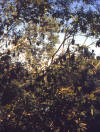
VIROLOGY
Appendix
Nipah Virus and Lychees
Dr Swati Tomar
FEEDBACK

The natural reservoir for Nipah virus is still under investigation, but preliminary data suggest that bats of the genus Pteropus are also the reservoirs for Nipah virus in Malaysia.
CDC
 Transmission electron micrographs showing some of the
ultrastructural morphology found in the Nipah virus. The figure at the top
depicts a negative stain electron microscopic image of a single long
stranded nucleocapsid, on the bottom left depicts a thin section EM image of
a mature virus particle, and on the bottom right depicts a thin section EM
image of nucleocapsids apposed to the plasma membrane of an infected cell.
Transmission electron micrographs showing some of the
ultrastructural morphology found in the Nipah virus. The figure at the top
depicts a negative stain electron microscopic image of a single long
stranded nucleocapsid, on the bottom left depicts a thin section EM image of
a mature virus particle, and on the bottom right depicts a thin section EM
image of nucleocapsids apposed to the plasma membrane of an infected cell.
CDC/Cynthia Goldsmith
 Immunohistochemistry of a tissue section showing
cytoarchitectural histopathologic changes associated with a Nipah virus
infection.
Immunohistochemistry of a tissue section showing
cytoarchitectural histopathologic changes associated with a Nipah virus
infection.
CDC/Dr Brian Mahy
 Immunohistochemistry of a canine renal specimen showing cytoarchitectural
histopathologic changes associated with a Nipah virus infection. CDC/Dr
Brian Mahy
Immunohistochemistry of a canine renal specimen showing cytoarchitectural
histopathologic changes associated with a Nipah virus infection. CDC/Dr
Brian Mahy
A seemingly innocuous summer fruit, Lychee (Litchi chinensis Sonn.,
Sapindaceae), made headlines across Indian newspapers as being the primary
cause of deaths of seven children in Malda district of West Bengal. Most
probable reasons were found to be a rare form of viral encephalopathy which
results in high grade fever, vomiting and convulsions.
This outbreak was first reported in China and Vietnam (J Paireau, 2012) with a
recent report from Muzaffarpur, Bihar (K Laserson, 2013). The viral infection
referred to as acute encephalitis syndrome (AES) or acute neurological syndrome
(ANS) was locally termed Ac Mong encephalitis (AME) in Vietnam, after the
Vietnamese word for nightmare. The Vietnamese study reported that the epidemics
occurred earlier in the districts that harvested litchis during May–June than in
those that harvested litchis during June–July (J Paireau, 2012). One possible
explanation for transmission of virus from a fruit to humans was that
fruit-bearing litchi trees attracted bats, which in turn might be the reservoir
for the putative pathogen. Mosquitoes could thus be a carrier for the virus from
the infected bats to humans (J Paireau, 2012). Other possibilities could be
direct contamination of litchis with bat saliva, urine, or guano (Wacharapluesadee
S, 2005) or drawing parallels from Chandipura virus, transmission could
be from insects found in litchi trees or phlebotomine sand flies (Geevarghese G,
2005). Lastly, there might be a connecting link between human feces used as
fertilizers to enhance litchi growth and contamination of soil with
enteroviruses, which are notorious for causing fatal encephalitis in
malnourished children (Sapkal GN, 2009). The leading litchi-producing countries
happen to be China, India, Taiwan, Thailand, and Vietnam (Evans EA, 2005) and
that might be the reason why these countries are experiencing such outbreaks.
Amidst these possibilities, the actual causative pathogen and its transmission
is still unknown. An epidemiological study delineating the causal factors of ANS
caused by Litchi in India would bring more insights into the issue.
Additionally, Lychee seed extracts were found to possess significant in-vitro
antiviral properties against Coxsackie virus B3 (CVB3) Nancy strain and herpes
simplex virus 1 (HSV-1) (Xinya Xu, 2010). Oligonol, a purified phenolic extract
from lychee fruit and green tea, was reported to serve as antiviral agent
against betanodavirus (Ichinose T, 2013) and influenza virus A/HK (H3N2) (L.
Gangehei, 2010).
What is intriguing is that despite possessing such inherent antiviral
properties, litchi happens to be a carrier for viral encephalopathy! It would be
of interest to study the brain extracts of patients for viral pathogens and do a
functional analysis of antiviral properties against the specific virus types.
Return to Viral Diseases transmitted by vertebrates chapter
Return to the Virology section of Microbiology and Immunology On-line
Return to the Home Page of Microbiology and Immunology On-line
This page last changed on Wednesday, November 23, 2016
Page maintained by Richard Hunt
